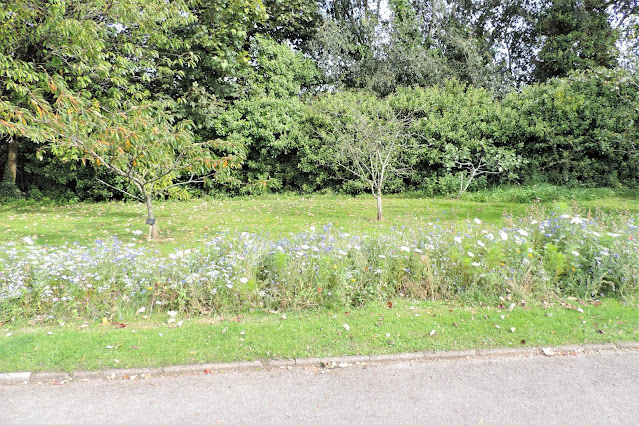The Ivy is just starting to bloom, so there were very few species feeding the best being Volucella pellucens. So I turned my attention back to last weeks flowerbed of White Laceflower, Japanese Anemone and Cornflower. There were a further 14 species feeding there, species new from last week included Melanostoma mellinum (m), Sphaerophoria scripta (m), Cheilosia impressa (m), Rhingia campestris (m) and Syritta pipiens (15). The commonest species was Eristalis tenax (25). Not much else about besides Red Admiral and Speckled Wood butterflies. Although a female Common Darter resting on a Rose flower was unusual.
Sunday, 27 September 2020
Monday, 21 September 2020
Sunday
With only a short window, I visited the scabious patch again, it was still going strong with 20 species seen, highlights included Eupeodes latifasciatus (f), Xanthogramma pedissequum (f) and Sericomyia silentis (12). Most numerous species was again Eristalis tenax (55).
A Dock Bug was new for the C.O.P. and 10 Silver Y were feeding on Devilsbit Scabious. 4 species of common butterfly were also present. A singing Garden Warbler in the bungalow trees was a bit of a surprise though.
Saturday, 19 September 2020
Saturday
Fine weather but a strong north easterly wind, meant the 20c temperature felt more like 15c. With most of the flower areas now out of bloom , I payed a short visit to three places to check out whether the Ivy was in bloom.
Maesteg Welfare park
The Ivy here [background of 2nd photo) was yet to open, but the flower bed in front of it had a few ornamental flowers which were attracting hoverflies particularly the ornamental umbellifer Orlaya grandiflora (White Laceflower) and Anemone hupehensis var. jappnicax hybryda (Japanese Anemone). 13 species of hoverfly were recorded in this small one bed, with the commonest being Eristalis arbustorum (6) and Cheilosia scutellata (6).
Maesteg Cemetery
I visited at the wrong time of the day and the Ivy although starting to open was in the shade and I only recorded 8 species with the best being Sericomyia silentis (f).
Lletty Brongu woods
This small Ivy patch over the stream by the farm was very productive, holding 15 species of hoverfly, with Eristalis arbustorum again the commonest (8) species. The best from the woods included Eupeodes luniger (f), Riponnensia splendens (m) and Helophilus pendulus (3).
Between the three sites I also saw the butterflies Comma (1), Red Admiral (4), Small White (2) and Speckled Wood (4). Also 3 Green Shieldbug were seen.
Thursday, 10 September 2020
Devilsbit Scabious patch revisited
Revisited the scabious patch by Newtown Bungalows, Caerau to see what was about. Still in full bloom and lots of insects feeding in the afternoon sunshine.
18 species of hoverfly seen, which is good for the time of year. My first Eupeodes latifasciatus (f) of the year was seen [species number 105 for the year]. Other highlights included a Rhingia rostrata (m) among the campestris present, Helophilus trivittatus (3), Helophilus pendulus (12) and Sericomyia silentis (6). Eristalis tenax (100) was the most numerous again. Also took a Platycheirus as a specimen which keys out to one of the rare ones, but will have to wait until the end of the year when I send my specimens off to Roger Morris of the Hoverfly Recording Scheme. Only downer was my camera battery run out after 12 shots.
Other insects present included good numbers of the migrant moth Silver Y (20) and 5 species of butterfly including Red Admiral. Also seen was the locally scarce Tachinid Fly Nowickia ferox and the Tortoise Shieldbug.















